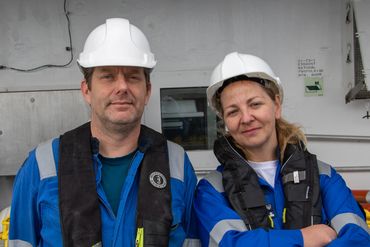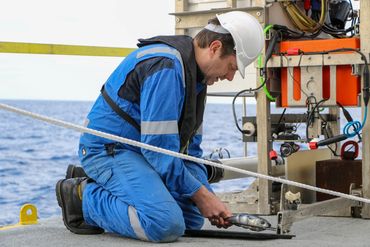CRUISES
Trans-Pacific leg 1&2
THE MUDSRC TEAM LEADS AMBITIOUS PACIFIC ABYSSAL PLAINS EXPEDITION
Scientists from the UWA-Minderoo Deep-Sea Research Centre have embarked on an ambitious expedition to study the diversity of deep-sea life across the vast abyssal plains of the Pacific Ocean.
In collaboration with Inkfish, the expedition onboard the RV Dagon is in six 3-week legs. Half of the legs will cross between the West coast of America and Hawaii at three different latitudes, and the other 3 cross between Hawaii and Tahiti at three different longitudes.
Each trip is approximatly 2800 nautical miles(nm) and the team are deploying three deep-sea landers, equipped with baited cameras, traps and oceanographic sensors, approximately every 200 nm throughout.
The first two legs, led by Prof Alan Jamieson, have concluded reaching Tahiti on July 15th. During these first two legs the team achieved 44 lander deployments at 15 sites between 4000 and 6700 metres deep, that spanned 5601 nm of abyssal plain.
The team that included Melanie Stott and Jenny Wainwright, worked closely with Inkfish and Heather Stewart from the British Geological Survey (UK) and managed to map over 120,000km2 of deep-seafloor and acquired over 420,000 metres of oceanographic profile data.
The landers collected a very large volume of video data that included incredible high-definition video of deep-sea grenadiers (Coryphaenoides), cusk eels (Bassozetus, Spectrunculus, Barathrites), lizardfish (Bathysaurus) various decapods (Cerataspis, Benthesicymus) and many amphipods (Paralicella, Eurythenes, and the supergiant Alicella).
After a quick port call in Tahiti, the team swapped out for Todd Bond, Jessica Kolbusz and Megan Cundy who will take a more westerly route back to Hawaii, and a more southerly route back to San Diego.
Later in the year, various members of the team will rejoin for legs 5 and 6 which will see the final two transits back to Tahiti via Hawaii, and this time with the inclusion of the submersible Bakunawa.
study site

Highfin Lizard Fish
An elegant Bathysaurus mollis takes off, 5000m deep, Pacific Ocean
Cusk Eel
A curious Bassozetus sp. 4500m deep, Pacific Ocean
life on the abyssal plains

Bassozetus sp

Alicella gigantea

Benthesicymus crenatus

Enypniastes sp

Bassozetus and Coryphaenoides

Pachycara sp

Lobate Ctenophore

Narcomedusae and Coryphaenoides yaquinae

Polynoidae

Spectrunculus sp

Barathrites sp
Expedition LEADERS Prof Alan jamieson and heather stewart



Copyright © 2024 University of Western Australia - Deep Sea Centre - All Rights Reserved.
Powered by GoDaddy
This website uses cookies.
We use cookies to analyze website traffic and optimize your website experience. By accepting our use of cookies, your data will be aggregated with all other user data.